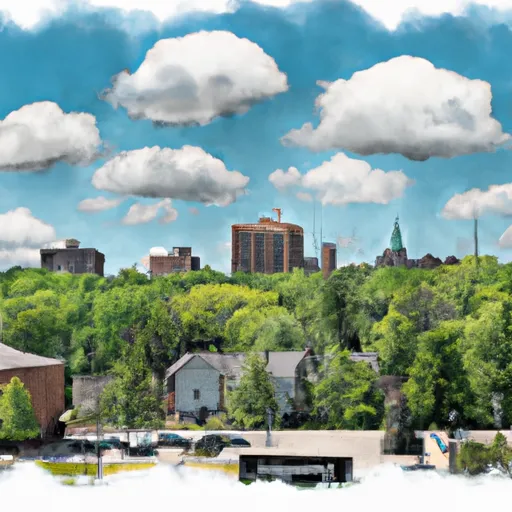-
 Snoflo Premium
Snoflo Premium
Get unlimited access to all our content
With no Ad interruptions! - Start Your Free Trial Login with existing account
Huntington-Woods
Eden Index
Climate
7.8
•
Recreation
4.2
•
Community
3.4
•
Safeguard
5.4/10

Huntington Woods is a small suburban city located in southeastern Michigan, about 10 miles north of downtown Detroit. The city experiences a humid continental climate, characterized by warm summers and cold winters. Summers are typically mild to warm, with average temperatures ranging from 70°F to 85°F, while winters are cold with temperatures averaging between 20°F and 35°F. Precipitation is evenly distributed throughout the year, and snowfall is common during the winter months.
Regarding hydrology constituents, Huntington Woods is not home to any major lakes, rivers, or water bodies. However, it is part of the larger Detroit River watershed, which offers opportunities for water-based activities such as boating, fishing, and kayaking, just a short drive away.
Despite its limited hydrological features, Huntington Woods offers a variety of outdoor recreational opportunities. The city has several parks and green spaces, providing ample space for picnicking, walking, jogging, and playing sports. Burton Community Park, Scotia Park, and Rackham Golf Course are among the popular recreational areas in the city. Additionally, residents can access nearby nature preserves and state parks for hiking, camping, and wildlife observation.
What is the Eden Index?
The Snoflo Eden Index serves as a comprehensive rating system for regions, evaluating their desirability through a holistic assessment of climate health, outdoor recreation opportunities, and natural disaster risk, acknowledging the profound impact of these factors on livability and well-being.
Climate Health Indicator (CHI): 7.8
Huntington-Woods receives approximately
842mm of rain per year,
with humidity levels near 80%
and air temperatures averaging around
10°C.
Huntington-Woods has a plant hardyness factor of
6, meaning
plants and agriculture in this region thrive during a short period during spring and early summer. Most
plants will die off during the colder winter months.
By considering the ideal temperature range, reliable water supplies, clean air, and stable seasonal rain or snowpacks, the Climate Health Indicator (CHI) underscores the significance of a healthy climate as the foundation for quality living.
A healthy climate is paramount for ensuring a high quality of life and livability in a region, fostering both physical well-being and environmental harmony. This can be characterized by ideal temperatures, reliable access to water supplies, clean air, and consistent seasonal rain or snowpacks.
Weather Forecast
Streamflow Conditions
St. Clair-Detroit
Area Rivers
St. Clair-Detroit
Snowpack Depths
St. Clair-Detroit
Reservoir Storage Capacity
St. Clair-Detroit
Groundwater Levels
Recreational Opportunity Index (ROI): 4.2
The Recreational Opportunity Index (ROI) recognizes the value of outdoor recreational options, such as parks, hiking trails, camping sites, and fishing spots, while acknowledging that climate plays a pivotal role in ensuring the comfort and consistency of these experiences.
Access to outdoor recreational opportunities, encompassing activities such as parks, hiking, camping, and fishing, is crucial for overall well-being, and the climate plays a pivotal role in enabling and enhancing these experiences, ensuring that individuals can engage in nature-based activities comfortably and consistently.
Camping Areas
| Campground | Campsites | Reservations | Toilets | Showers | Elevation |
|---|---|---|---|---|---|
| Addison Oaks County Park | None | 993 ft | |||
| Evergreen County Park | 147 | 740 ft | |||
| Metamora - Hadley Rec Area | 215 | 934 ft | |||
| Sterling State Park | 250 | 579 ft | |||
| Holiday Beach Conservation Area | None | 578 ft |
Nearby Ski Areas
Catastrophe Safeguard Index (CSI):
The Catastrophe Safeguard Index (CSI) recognizes that natural disaster risk, encompassing floods, fires, hurricanes, and tornadoes, can drastically affect safety and the overall appeal of an area.
The level of natural disaster risk in a region significantly affects safety and the overall livability, with climate change amplifying these risks by potentially increasing the frequency and intensity of events like floods, fires, hurricanes, and tornadoes, thereby posing substantial challenges to community resilience and well-being.
Community Resilience Indicator (CRI): 3.4
The Community Resilience Indicator (CRI) recognizes that education, healthcare, and socioeconomics are crucial to the well-being of a region. The CRI acknowledges the profound impact of these elements on residents' overall quality of life. By evaluating educational resources, healthcare accessibility, and economic inclusivity, the index captures the essential aspects that contribute to a thriving community, fostering resident satisfaction, equity, and social cohesion.

